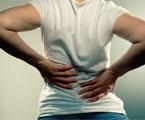Massage Therapy Holds Promise for Low-Back Pain
Massage therapy helped reduce pain and improve function more rapidly than usual medical care in people with chronic low-back pain, according to researchers at Group Health Research Institute and the University of Washington in Seattle, the Oregon Health and Science University in Portland, and the University of Vermont in Burlington. The purpose of the NCCAM-funded trial—published in the Annals of Internal Medicine—was to compare the short-term and long-term effects of structural massage, relaxation massage, and usual care for people with chronic low-back pain. Back pain is an important health problem that affects millions of Americans and is the most common medical condition for which people use complementary and alternative medicine practices, such as massage therapy.
The trial enrolled just over 400 Group Health patients who had low-back pain with no identified cause for at least 3 months. The participants were randomly assigned to one of three treatment groups: structural massage, relaxation massage, or usual care (standard medical care). Study personnel who assessed outcomes were blinded to treatment assignment. It was not possible to blind participants or massage therapists. Structural massage is intended to address musculoskeletal causes of back pain through myofascial, neuromuscular, and various soft-tissue techniques. Relaxation massage (similar to Swedish massage) is intended to promote a sense of relaxation through techniques, such as long strokes, kneading, deep circular movements, or vibration. Usual care for low-back pain may include medication, other forms of physical therapy, back exercises, and education.
Participants assigned to the massage groups received 1 hour of massage once a week for 10 weeks. The participants’ symptoms, medication use, and ability to perform daily functions were measured after completion of the 10 treatments, then at 6 months, and again after 1 year.
Significantly greater improvements in disability and bothersomeness of symptoms were seen at 10 weeks in both massage groups compared to those who received usual care. For example, at 10 weeks massage recipients were better able to perform daily activities, were more active, spent fewer days in bed, and used less anti-inflammatory medication than those who received usual care. Some of these benefits persisted at 6 months, but at 1 year the benefits of massage over usual care were not significant—when pain and function across all three groups had improved about evenly.
The researchers point out that the mechanisms by which massage helped in this study remain unclear—benefits could come from specific local effects on the body, or from non-specific effects such as a relaxing environment, being touched, or increased body awareness. The study provides additional evidence that, as the researchers conclude, massage therapy can be a helpful adjunct in treating chronic low-back pain. While these results are promising, additional research is needed to understand better why some patients improve and others do not, and to help define optimal and cost-effective approaches to integration of massage into care of patients with chronic low-back pain.
References
-
Cherkin DC, Sherman KJ, Kahn J, et al. A comparison of the effects of 2 types of massage and usual care on chronic low-back pain: a randomized, controlled trial. Annals of Internal Medicine.; 155(1):1–9.2011
Additional Resources
Sign up for one of our email or RSS notifications to learn when new CAM-related information is available.

